Comparative Study of Different Measurement Methods for Characterizing Rheological Properties of Lubrication Layer
Abstract
:1. Introduction
2. Experimental
2.1. Materials
2.2. Mix Proportions
2.3. Testing Procedure
2.3.1. Mixing
2.3.2. Rheological Measurement of Constitutive Mortar
2.3.3. Rheological Measurement with Sliper
2.3.4. Rheological Measurement of Concrete
2.3.5. Rheological Measurement with Tribometer
3. Results and Discussion
3.1. Viscosity of the Lubrication Layer
3.2. Yield Stress of the Lubrication Layer
3.3. Workability of Concrete
3.4. Discussion
4. Conclusions
- (1)
- The viscosity of the lubrication layer obtained through the mortar rheology was the highest, while that gained by Sliper was the smallest of all the measurement systems. However, it could be found that the yield stress determined with Sliper was significantly higher than other experimental results. The linear correlation between the rheological parameters gained by different methods was more obvious between the measurement with tribometer and mortar rheometer.
- (2)
- There was a good linear relationship between the rheological parameters of the lubrication layer determined through tribometer or mortar rheometer and the rheological parameters of concrete. However, the correlation coefficient between the experimental results obtained with Sliper and rheological properties of concrete was not high enough.
- (3)
- There was a good linear relationship between the workability indicators and the rheological parameters of bulk concrete. The workability of fresh concrete might only be suitable to predict the rheological properties of bulk concrete.
- (4)
- The friction caused by the rubber ring and the leaking mortar during the Sliper measuring results in a significantly overestimated yield stress of the lubrication layer. The segregation of concrete leads to the error of experimental results obtained by the tribometer. The difference in the formation of the lubrication layer results in the systematic deviation between different methods.
Author Contributions
Funding
Institutional Review Board Statement
Informed Consent Statement
Data Availability Statement
Acknowledgments
Conflicts of Interest
List of Symbols
| height of vane rotor (m) | |
| radius of the vane rotor or the inner cylinder (m) | |
| radius of the outer cylinder (m) | |
| T | torque (N·m) |
| Ω | angular velocity of cylinder (rad/s) |
| , , | yield stress of lubrication layer measured by mortar rheometer, Sliper, and tribometer, respectively (Pa) |
| , , | plastic viscosity of lubrication layer measured by mortar rheometer, Sliper, and tribometer, respectively (Pa·s) |
| radius of cross-section of the plug flow (m) | |
| P | pressure (Pa) |
| Q | flow rate (m3/s) |
| , | viscous constant of the lubrication layer measured using Sliper and tribometer, respectively (Pa·s/m) |
| e | thickness of lubrication layer (m) |
| l | effective length of the Sliper pipe (m) |
| d | diameter of Sliper pipe (m) |
| distance from the center of the inner cylinder to the end of the lubrication layer in a radial direction (m) | |
| yield stress of concrete (Pa) | |
| plastic viscosity of concrete (Pa·s) | |
| shear rate (s−1) | |
| angular velocity contributed by the shear flow of lubrication layer (rad/s) | |
| effective height of the inner cylinder (m) | |
| shear stress (Pa) | |
| angular velocity contributed by the shear flow of concrete (rad/s) |
References
- Kwon, S.H.; Jang, K.P.; Kim, J.H.; Shah, S.P. State of the Art on Prediction of Concrete Pumping. Int. J. Concr. Struct. Mater. 2016, 10, 75–85. [Google Scholar] [CrossRef] [Green Version]
- Secrieru, E.; Cotardo, D.; Mechtcherine, V.; Lohaus, L.; Schröfl, C.; Begemann, C. Changes in concrete properties during pumping and formation of lubricating material under pressure. Cem. Concr. Res. 2018, 108, 129–139. [Google Scholar] [CrossRef]
- Feys, D.; Khayat, K.H.; Khatib, R. How do concrete rheology, tribology, flow rate and pipe radius influence pumping pressure? Cem. Concr. Compos. 2016, 66, 38–46. [Google Scholar] [CrossRef]
- Feys, D.; De Schutter, G.; Khayat, K.H.; Verhoeven, R. Changes in rheology of self-consolidating concrete induced by pumping. Mater. Struct. 2016, 49, 4657–4677. [Google Scholar] [CrossRef] [Green Version]
- Kaplan, D.; de Larrard, F.; Sedran, T. Avoidance of blockages in concrete pumping process. Aci Mater. J. 2005, 102, 183–191. [Google Scholar]
- Chao, Q.; Zhang, J.R.; Xu, B.; Wang, Q.N.; Huang, H.P. Test rigs and experimental studies of the slipper bearing in axial piston pumps: A review. Measurement 2018, 132, 135–149. [Google Scholar] [CrossRef]
- Tse, Y.L.; Cholette, M.E.; Tse, P.W. A multi-sensor approach to remaining useful life estimation for a slurry pump. Measurement 2019, 139, 140–151. [Google Scholar] [CrossRef]
- Vosahlik, J.; Riding, K.A.; Feys, D.; Lindquist, W.; Keller, L.; Van Zetten, S.; Schulz, B. Concrete pumping and its effect on the air void system. Mater. Struct. 2018, 51, 94. [Google Scholar] [CrossRef]
- Kim, J.H.; Han, S.H.; Choi, B.I. Influence of pumping pressure on the viscosity curve and rheological stability of mortar incor-porating polycarboxylate. Cem. Concr. Compos. 2020, 105, 7. [Google Scholar] [CrossRef]
- Rio, O.; Rodriguez, A.; Nabulsi, S.; Alvarez, M. Pumping Quality Control Method Based on Online Concrete Pumpability Assessment. ACI Mater. J. 2011, 108, 423–431. [Google Scholar]
- Xie, H.; Liu, F.; Fan, Y.; Yang, H.; Chen, J.; Zhang, J.; Zuo, C. Workability and proportion design of pumping concrete based on rheological parameters. Constr. Build. Mater. 2013, 44, 267–275. [Google Scholar] [CrossRef]
- Cu, Y.T.; Tran, M.V.; Ho, C.H.; Nguyen, P.H. Relationship between workability and rheological parameters of self-compacting concrete used for vertical pump up to supertall buildings. J. Build. Eng. 2020, 32, 101786. [Google Scholar] [CrossRef]
- Saak, A.W.; Jennings, H.M.; Shah, S.P. A generalized approach for the determination of yield stress by slump and slump flow. Cem. Concr. Res. 2004, 34, 363–371. [Google Scholar] [CrossRef]
- Secrieru, E.; Mohamed, W.; Fataei, S.; Mechtcherine, V. Assessment and prediction of concrete flow and pumping pressure in pipeline. Cem. Concr. Compos. 2020, 107, 103495. [Google Scholar] [CrossRef]
- Chen, J.; Xie, H.; Guo, J.; Chen, B.; Liu, F. Preliminarily experimental research on local pressure loss of fresh concrete during pumping. Measurement 2019, 147, 106897. [Google Scholar] [CrossRef]
- Choi, M.S.; Kim, Y.S.; Kim, J.H.; Kim, J.-S.; Kwon, S.H. Effects of an externally imposed electromagnetic field on the formation of a lubrication layer in concrete pumping. Constr. Build. Mater. 2014, 61, 18–23. [Google Scholar] [CrossRef]
- Feys, D. How much is bulk concrete sheared during pumping? Constr. Build. Mater. 2019, 223, 341–351. [Google Scholar] [CrossRef]
- Choi, M.S.; Kim, Y.J.; Jang, K.P.; Kwon, S.H. Effect of the coarse aggregate size on pipe flow of pumped concrete. Constr. Build. Mater. 2014, 66, 723–730. [Google Scholar] [CrossRef]
- De Schutter, G.; Feys, D. Pumping of Fresh Concrete: Insights and Challenges. RILEM Tech. Lett. 2016, 1, 76. [Google Scholar] [CrossRef] [Green Version]
- Le, H.D.; Kadri, E.H.; Aggoun, S.; Vierendeels, J.; Troch, P.; De Schutter, G. Effect of lubrication layer on velocity profile of concrete in a pumping pipe. Mater. Struct. 2015, 48, 3991–4003. [Google Scholar] [CrossRef]
- Yammine, J.; Chaouche, M.; Guerinet, M.; Moranville, M.; Roussel, N. From ordinary rhelogy concrete to self compacting concrete: A transition between frictional and hydrodynamic interactions. Cem. Concr. Res. 2008, 38, 890–896. [Google Scholar] [CrossRef]
- Morinaga, S. Pumpability of concrete and pumping pressure in pipelines. In Proceedings of the Rilem Seminar, Leeds, UK, 22–24 March 1973; pp. 1–39. [Google Scholar]
- Jacobsen, S.; Haugan, L.; Hammer, T.A.; Kalogiannidis, E. Flow conditions of fresh mortar and concrete in different pipes. Cem. Concr. Res. 2009, 39, 997–1006. [Google Scholar] [CrossRef]
- Choi, M.; Roussel, N.; Kim, Y.; Kim, J. Lubrication layer properties during concrete pumping. Cem. Concr. Res. 2013, 45, 69–78. [Google Scholar] [CrossRef]
- Phillips, R.J.; Armstrong, R.C.; Brown, R.A.; Graham, A.L.; Abbott, J.R. A constitutive equation for concentrated suspensions that accounts for shear-induced particle migration. Phys. Fluids A Fluid Dyn. 1992, 4, 30–40. [Google Scholar] [CrossRef]
- Leighton, D.; Acrivos, A. Measurement of shear-induced self-diffusion in concentrated suspensions of spheres. J. Fluid Mech. 1987, 177, 109–131. [Google Scholar] [CrossRef]
- Choi, M.S.; Park, S.B.; Kang, S.-T. Effect of the Mineral Admixtures on Pipe Flow of Pumped Concrete. J. Adv. Concr. Technol. 2015, 13, 489–499. [Google Scholar] [CrossRef] [Green Version]
- Choi, M.S.; Kim, Y.J.; Kwon, S.H. Prediction on pipe flow of pumped concrete based on shear-induced particle migration. Cem. Concr. Res. 2013, 52, 216–224. [Google Scholar] [CrossRef]
- Ngo, T.; Kadri, E.; Bennacer, R.; Cussigh, F. Use of tribometer to estimate interface friction and concrete boundary layer composition during the fluid concrete pumping. Constr. Build. Mater. 2010, 24, 1253–1261. [Google Scholar] [CrossRef]
- Jeong, J.H.; Jang, K.P.; Park, C.K.; Lee, S.H.; Kwon, S.H. Effect of Admixtures on Pumpability for High-Strength Concrete. ACI Mater. J. 2016, 113, 323–333. [Google Scholar] [CrossRef]
- Jang, K.P.; Choi, M.S. How affect the pipe length of pumping circuit on concrete pumping. Constr. Build. Mater. 2019, 208, 758–766. [Google Scholar] [CrossRef]
- Spangenberg, J.; Roussel, N.; Hattel, J.; Stang, H.; Skocek, J.; Geiker, M.R. Flow induced particle migration in fresh concrete: Theoretical frame, numerical simulations and experimental results on model fluids. Cem. Concr. Res. 2012, 42, 633–641. [Google Scholar] [CrossRef]
- Feys, D.; De Schutter, G.; Verhoeven, R. Parameters influencing pressure during pumping of self-compacting concrete. Mater. Struct. 2012, 46, 533–555. [Google Scholar] [CrossRef]
- Kim, J.S.; Kwon, S.H.; Jang, K.P.; Choi, M.S. Concrete pumping prediction considering different measurement of the rheological properties. Constr. Build. Mater. 2018, 171, 493–503. [Google Scholar] [CrossRef]
- Jiao, D.; Shi, C.; Yuan, Q.; An, X.; Liu, Y.; Li, H. Effect of constituents on rheological properties of fresh concrete—A review. Cem. Concr. Compos. 2017, 83, 146–159. [Google Scholar] [CrossRef]
- Kaplan, D.; de Larrard, F.; Sedran, T. Design of concrete pumping circuit. ACI Mater. J. 2005, 102, 110–117. [Google Scholar]
- Kwon, S.H.; Park, C.K.; Jeong, J.H.; Jo, S.D.; Lee, S.H. Prediction of Concrete Pumping: Part II—Analytical Prediction and Experimental Verification. ACI Mater. J. 2013, 110, 657–667. [Google Scholar]
- Feys, D.; Khayat, K.H. Recent developments in evaluating pumping behavior of flowable and self-consolidating concretes. J. Sustain. Cem. Mater. 2014, 4, 1–14. [Google Scholar] [CrossRef]
- Kwon, S.H.; Park, C.K.; Jeong, J.H.; Jo, S.D.; Lee, S.H. Prediction of Concrete Pumping: Part I—Development of New Tribometer for Analysis of Lubricating Layer. Aci Mater. J. 2013, 110, 647–655. [Google Scholar]
- Feys, D.; Khayat, K.H.; Perez-Schell, A.; Khatib, R. Development of a tribometer to characterize lubrication layer properties of self-consolidating concrete. Cem. Concr. Compos. 2014, 54, 40–52. [Google Scholar] [CrossRef]
- Feys, D.; Khayat, K.H.; Perez-Schell, A.; Khatib, R. Prediction of pumping pressure by means of new tribometer for highly-workable concrete. Cem. Concr. Compos. 2015, 57, 102–115. [Google Scholar] [CrossRef]
- Mechtcherine, V.; Nerella, V.N.; Kasten, K. Testing pumpability of concrete using Sliding Pipe Rheometer. Constr. Build. Mater. 2014, 53, 312–323. [Google Scholar] [CrossRef]
- Nerella, V.N.; Mechtcherine, V. Virtual Sliding Pipe Rheometer for estimating pumpability of concrete. Constr. Build. Mater. 2018, 170, 366–377. [Google Scholar] [CrossRef]
- Secrieru, E.; Butler, M.; Mechtcherine, V. Testing pumpability of concrete—From laboratory into practice. Bautechnik 2014, 91, 797–811. [Google Scholar] [CrossRef]
- CEN. Cement. Part 1: Composition, Specifications and Conformity Criteria for Common Cements; European Committee for Standardization: Brussels, Belgium, 2011. [Google Scholar]
- Kaplan, D. Pumping of Concretes. Ph.D. Thesis, Laboratoire Central des Ponts et Chausées, Paris, France, 2001. (In French). [Google Scholar]
- Sahraoui, M.; Bouziani, T. Effects of fine aggregates types and contents on rheological and fresh properties of SCC. J. Build. Eng. 2019, 26, 100890. [Google Scholar] [CrossRef]
- Bahrami, N.; Zohrabi, M.; Mahmoudy, S.A.; Akbari, M. Optimum recycled concrete aggregate and micro-silica content in self-compacting concrete: Rheological, mechanical and microstructural properties. J. Build. Eng. 2020, 31, 101361. [Google Scholar] [CrossRef]
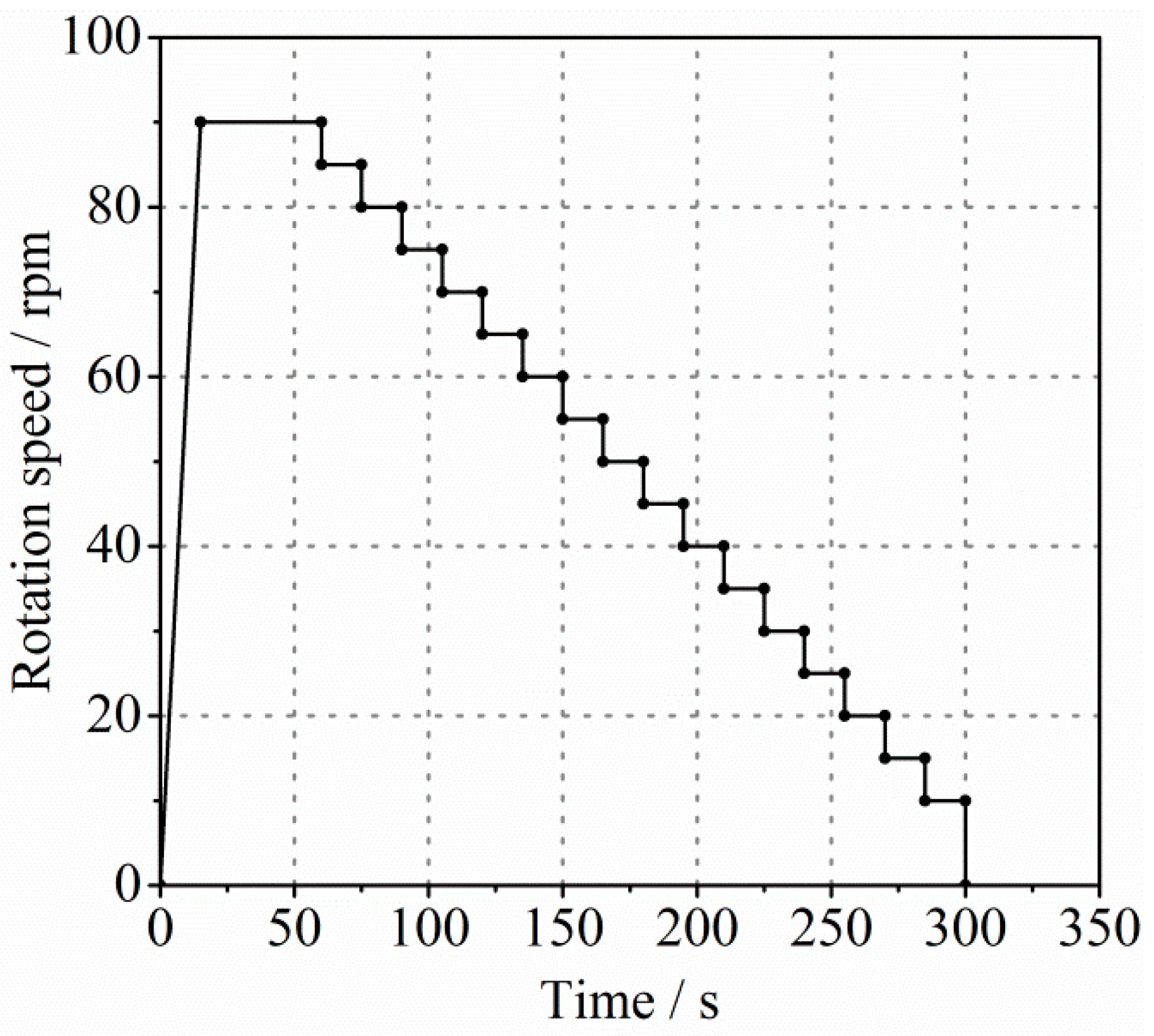

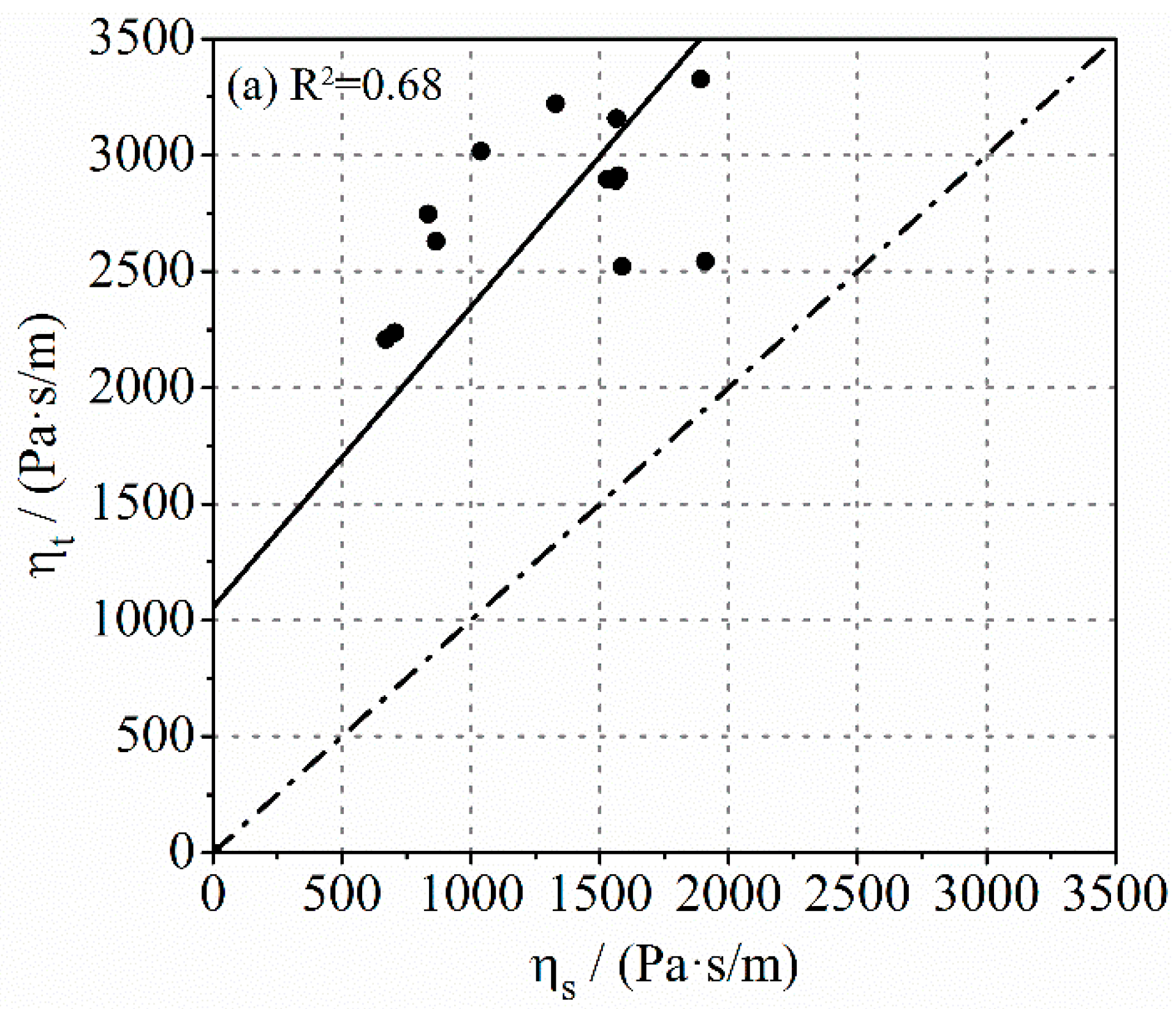
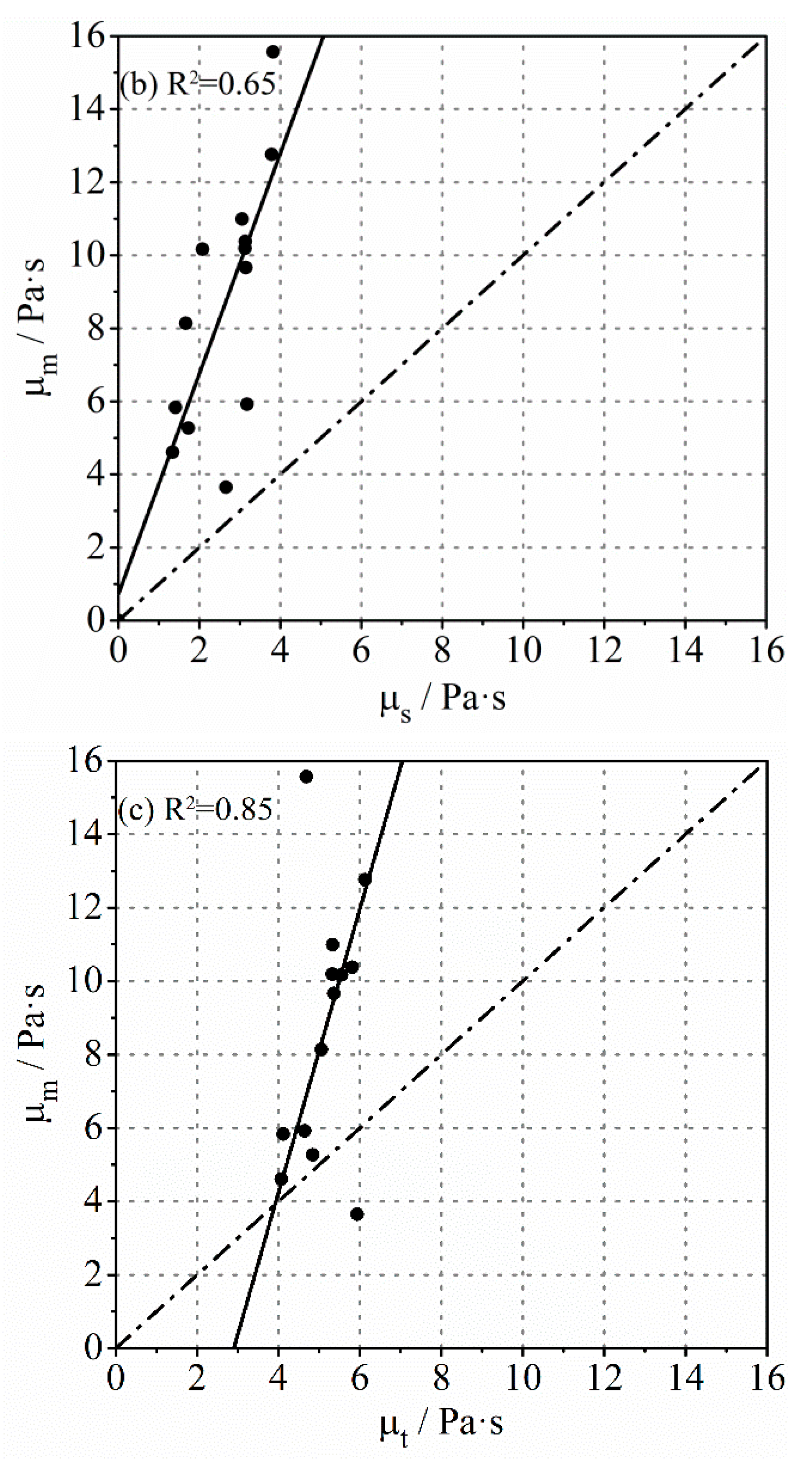
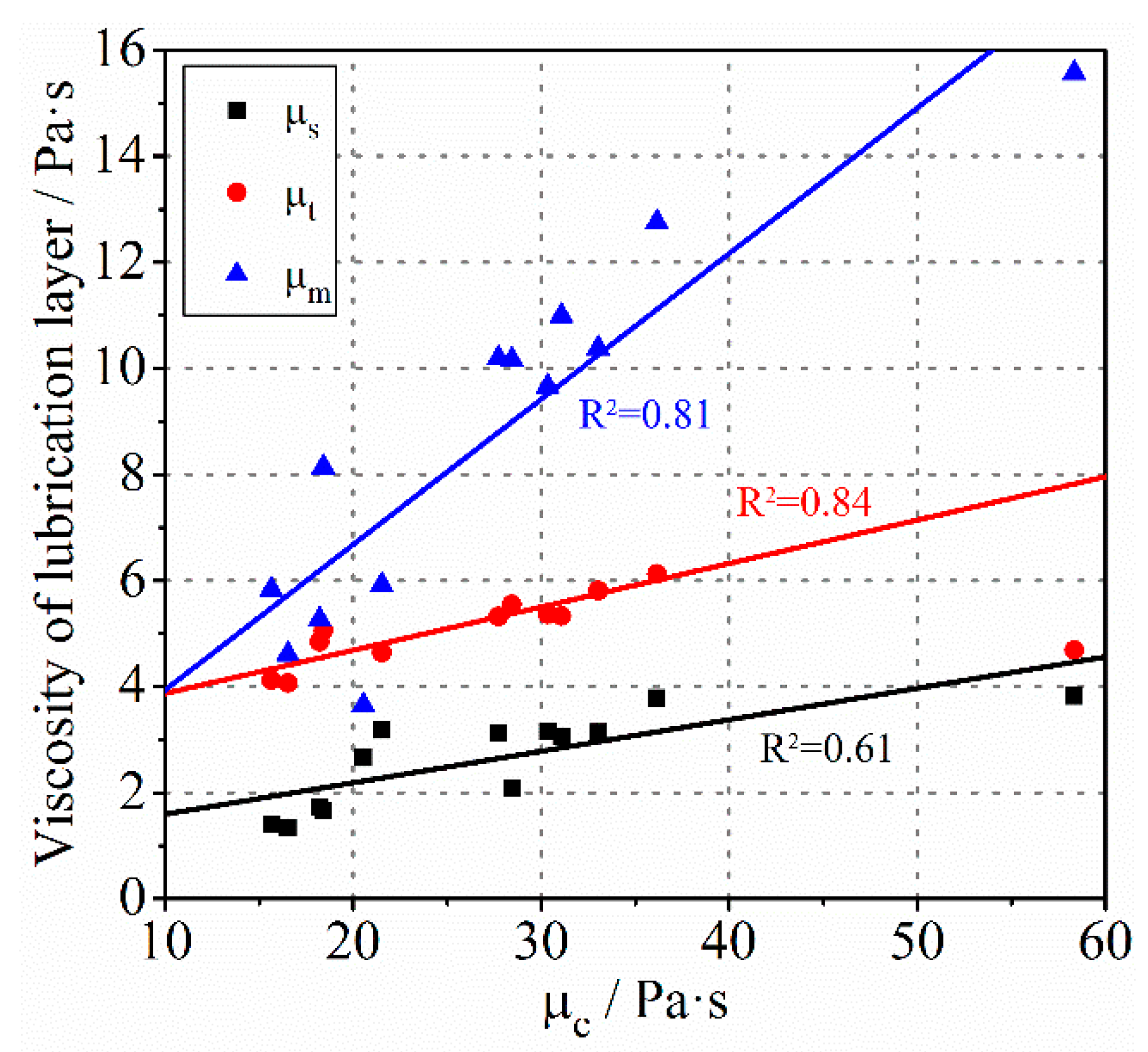


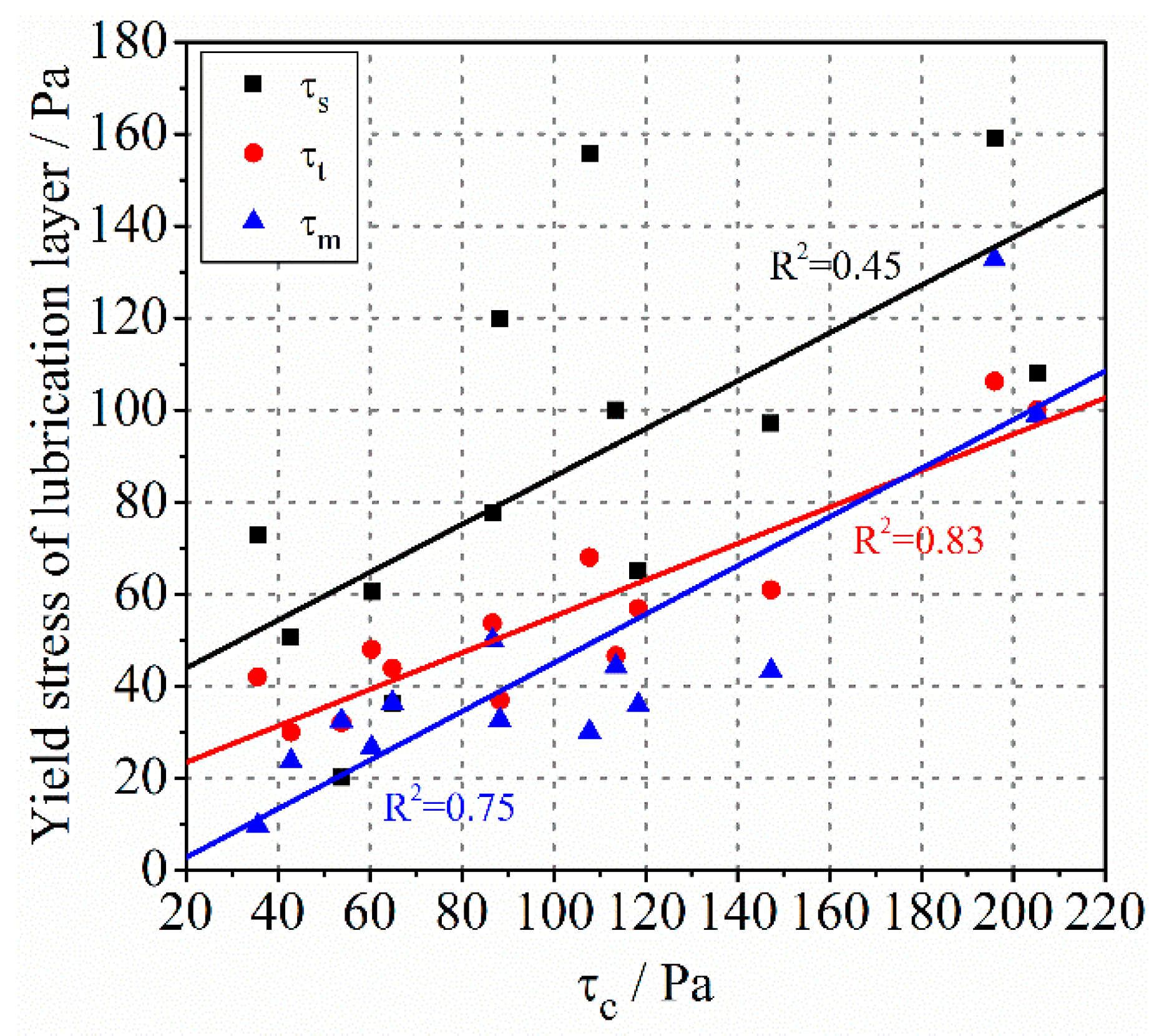
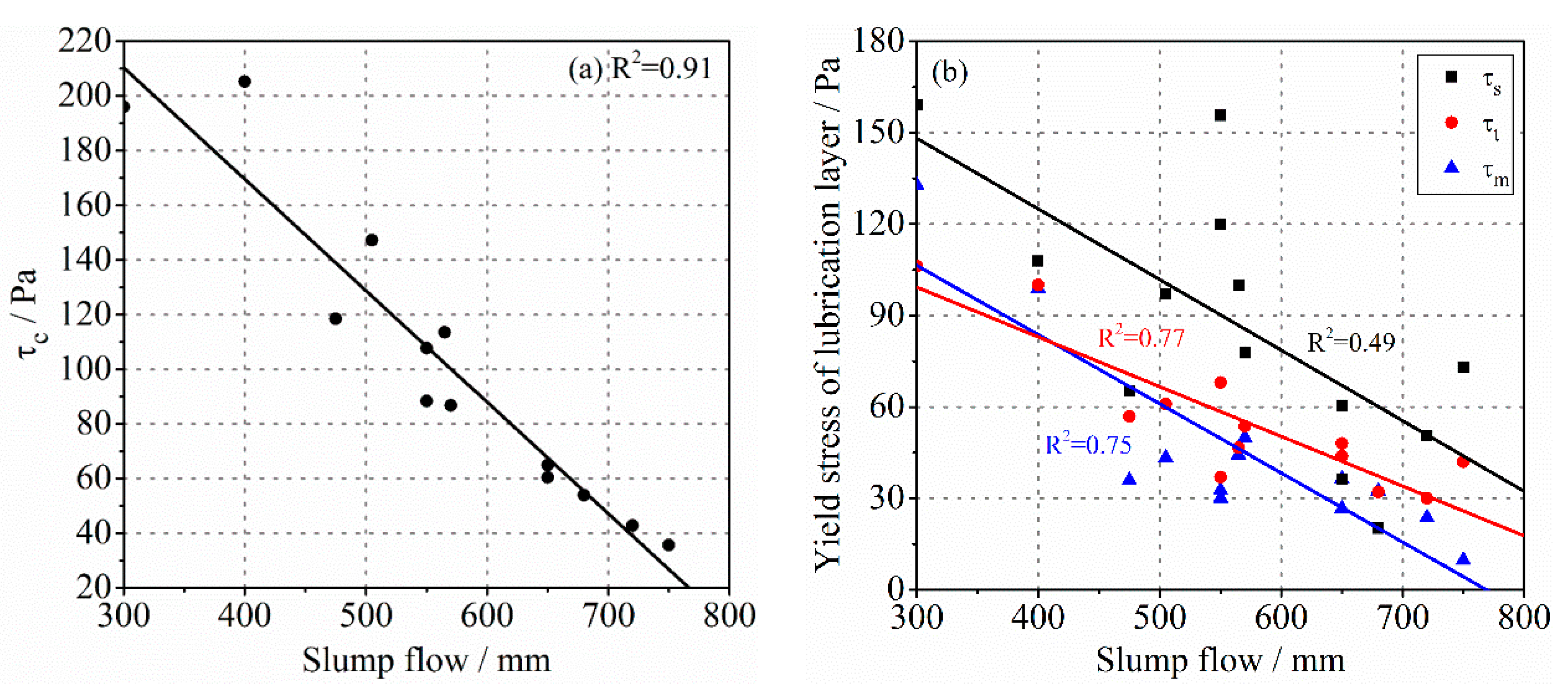
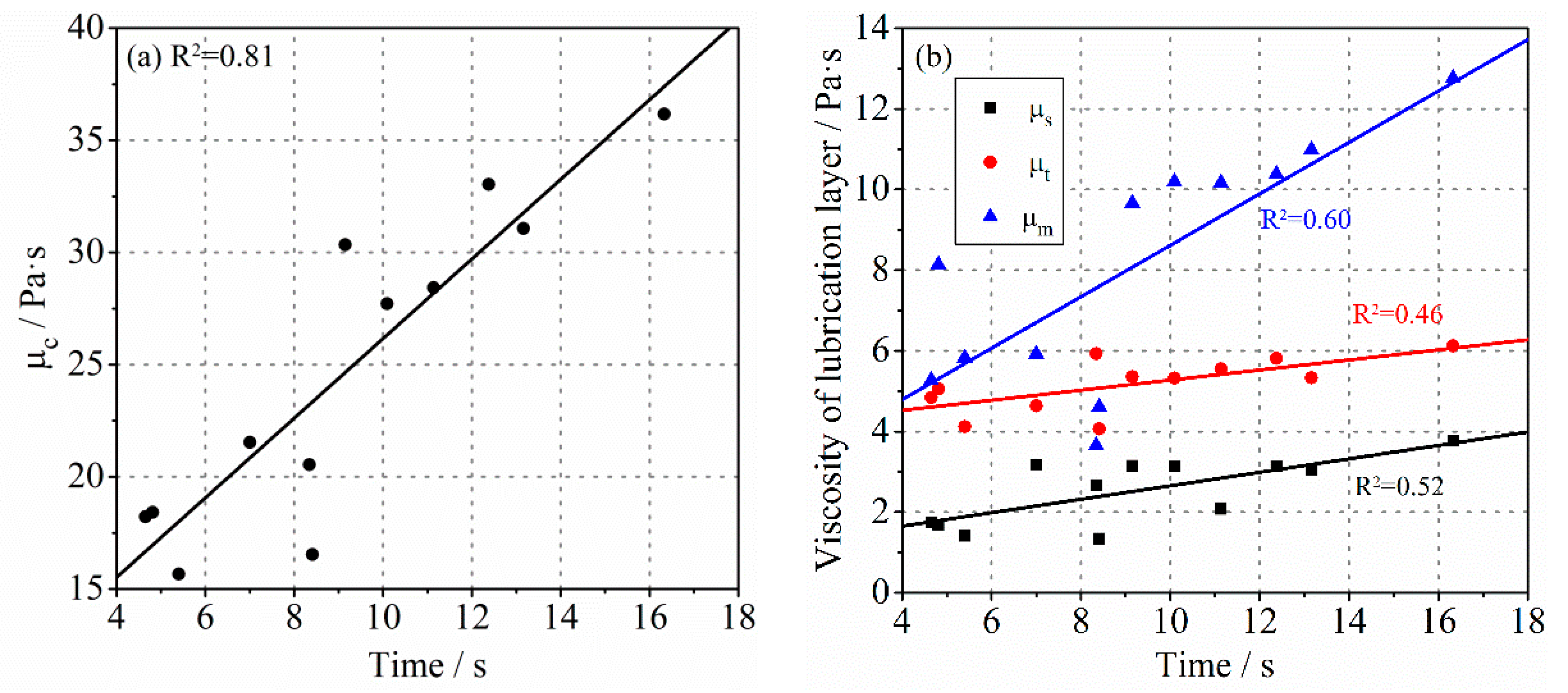
| Composition | CaO | SiO2 | Al2O3 | Fe2O3 | MgO | SO3 | Na2Oeq |
|---|---|---|---|---|---|---|---|
| Cement | 63.27 | 22.59 | 4.42 | 3.44 | 2.43 | 2.41 | 0.38 |
| Fly ash | 4.59 | 48.98 | 31.43 | 9.13 | 0.49 | 1.52 | 1.06 |
| Silica fume | 0.26 | 97.12 | 0.06 | 0.18 | 0.36 | 0.1 | 1.21 |
| Sample | Cement | Fly Ash | Silica Fume | Fine Aggregates | Coarse Aggregates | PCE | Sand Ratio/% | Paste-Aggregate Ratio/% | W/B Ratio |
|---|---|---|---|---|---|---|---|---|---|
| C1 | 401 | 150 | 25 | 823 | 794 | 4.90 | 51 | 63 | 0.3 |
| C2 | 401 | 150 | 25 | 823 | 794 | 5.48 | 51 | 63 | 0.3 |
| C3 | 401 | 150 | 25 | 823 | 794 | 6.34 | 51 | 63 | 0.3 |
| C4 | 401 | 150 | 25 | 823 | 794 | 7.20 | 51 | 63 | 0.3 |
| C5 | 401 | 150 | 25 | 823 | 794 | 8.35 | 51 | 63 | 0.3 |
| C6 | 401 | 150 | 25 | 728 | 890 | 6.34 | 45 | 63 | 0.3 |
| C7 | 401 | 150 | 25 | 776 | 841 | 6.34 | 48 | 63 | 0.3 |
| C8 | 401 | 150 | 25 | 873 | 744 | 6.34 | 54 | 63 | 0.3 |
| C9 | 401 | 150 | 25 | 922 | 695 | 6.34 | 57 | 63 | 0.3 |
| C10 | 319 | 119 | 21 | 933 | 900 | 6.34 | 51 | 44 | 0.3 |
| C11 | 360 | 135 | 23 | 878 | 847 | 6.34 | 51 | 53 | 0.3 |
| C12 | 442 | 165 | 29 | 768 | 741 | 6.34 | 51 | 75 | 0.3 |
| C13 | 483 | 181 | 31 | 714 | 688 | 6.34 | 51 | 88 | 0.3 |
Publisher’s Note: MDPI stays neutral with regard to jurisdictional claims in published maps and institutional affiliations. |
© 2021 by the authors. Licensee MDPI, Basel, Switzerland. This article is an open access article distributed under the terms and conditions of the Creative Commons Attribution (CC BY) license (https://creativecommons.org/licenses/by/4.0/).
Share and Cite
Liu, Y.; Jing, R.; Yan, P. Comparative Study of Different Measurement Methods for Characterizing Rheological Properties of Lubrication Layer. Molecules 2021, 26, 3889. https://doi.org/10.3390/molecules26133889
Liu Y, Jing R, Yan P. Comparative Study of Different Measurement Methods for Characterizing Rheological Properties of Lubrication Layer. Molecules. 2021; 26(13):3889. https://doi.org/10.3390/molecules26133889
Chicago/Turabian StyleLiu, Yu, Rui Jing, and Peiyu Yan. 2021. "Comparative Study of Different Measurement Methods for Characterizing Rheological Properties of Lubrication Layer" Molecules 26, no. 13: 3889. https://doi.org/10.3390/molecules26133889
APA StyleLiu, Y., Jing, R., & Yan, P. (2021). Comparative Study of Different Measurement Methods for Characterizing Rheological Properties of Lubrication Layer. Molecules, 26(13), 3889. https://doi.org/10.3390/molecules26133889






